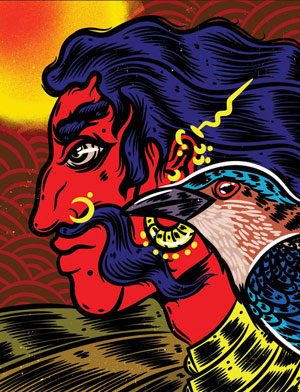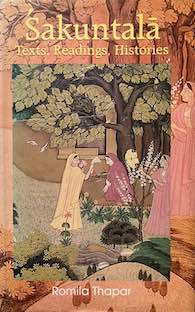By Romila Thapar, Emeritus Professor of History, Jawaharlal Nehru University
The hunt introduces us to the forest dwellers. These tended to be either creatures of the imagination such as the raksasas who are abundant, or else humans with supernatural faculties. Raksasas have generally been described as demons and as unreal. But given the perceptions of the forest in the epics, they are as likely to be the unfamiliar forest dwellers who obstructed hunting expeditions and harassed those establishing settlements in the forest, for example, rsis establishing asramas. Or are they societies contrasted with monarchy, such as the more sophisticated raksasas of the Ramayana? Moreover, is the hunt also an aspect of the subordination of nature to culture? If the forest is seen as a place which is without order or discipline, then it is required of the raja to control it and the hunt becomes the beginning of such control, even if it is initially chaotic. This subordination was also achieved, perhaps less traumatically, through the setting up of asramas in the forest. ln the narrative of Sakuntala, the ferocity of the hunt is contrasted with the gentle calm of the hermitage, each presenting a different view of nature. The hermitage is set so deep in the forest that it is almost another world, enveloped in a translucent green of sun and trees. This is liminal space, the threshold between the two contrasting ecologies of the vana and the ksetra. But at the same time it may be seen as a precursor of what later evolved into agraharas – grants of land to brahmanas – in forests or wastelands, or grants of cultivated land. The asrama is at one level an intrusion into the forest by the people of the grama, an intrusion sought to be stemmed by those living in the forest. […]
The preferred choice was a place distant from the settlement so that there would be few intrusions, which is ironic, since the hermitage itself was an intrusion. Its way of life was a denial of that associated with the settlement. Renouncers having renounced social obligations, had to live where such obligations and duties were not required. Rituals were performed, but only for the members of the asrama. Food was gathered from what the forest provided and cultivation was marginal. The attempt was to live in unison with the rhythms of the forest world, even if not in amity with the forest people.
The suggestion for a hermitage could have come from the existing sacred groves, located either on the peripheries, or in the dense areas of the forest. The former would be tended by the settlement and the latter by the forest dwellers. A small forest was dedicated to a deity, was left uncut, and had a space for offerings and activities demanded by rituals focusing sometimes on a shrine located in the grove. […]
The forest was never far away from habitation. For instance, excavations of the settlements at Atranjikhera and Hastinapur, which are not too far from Delhi, have yielded evidence of a large variety of forest trees. The Buddhist Canon states that aside from the village and its outskirts, the rest of the land is jungle. Even as late as the seventh century A.D., the Chinese Buddhist monk Hsuan Tsang writes of forests close to Kausambi, as also of the extensively forested areas in the vicinity of Kapilavastu and Kusinagara in the terai and north Bihar. Travelling from one town to another meant going through a forest. Therefore, when in exile, the forest was not a physically distant place, although distant in concept. The exile of heroes in both epics is to the forest. But here the forest takes on a different connotation and is not merely the jungle beyond the settlement. The state, as the location of the state was also advised to take the initiative in developing forests, especially those featuring particular kinds of forest produce, and to settle people in forests who would be trained to garner this produce and to convert it into items for commerce. Elephant forests were especially prized, for not only was the ivory valuable but it was also thought that victory in battle depended principally on the elephant wing of the army. Furthermore, such forests made excellent natural frontiers. That these activities of the state may have met with some opposition from forest dwellers is suggested by Kautilya’s remark that the king should not tax those areas which had been laid waste by the atavika/forest dwellers. What form this opposition took is not specified, but the exemption from tax for those cultivators affected by the activities of the forest people would suggest that perhaps the crops of the cultivators were burnt. He also cautions against forest chieftains who were numerous, visible, brave and could ruin a country. They could be allies or could be used politically to create trouble for neighbouring kingdoms.” Forest peoples–aranyacaracatavika–are a distinct category, known and visible, in the text. […]
Was the threat to forest dwellers a way of preventing the illegal clearing of forests and of curbing shifting cultivation? Was Asoka, being a conscientious Buddhist, trying to wean away the atavikas from a life of hunting and killing animals, or was the state ensuring that its appropriation of forest produce would not be obstructed by forest dwellers? Or was the state protecting forest dwellers? There was at that time enough forested land for there to be no fear of the disappearance of forests. Shifting cultivation, therefore, may not have been viewed as a disaster, for it also permitted the growth of a secondary forest. […]
What were once the perceptions of the forest in the epic, focusing on the hunt, the hermitage and exile were now beginning to fade. Banabhatta’s description would pertain to the middle of the first millennium A.D. Villages in the forest as described by Banabhatta are large and well stocked. In addition to cowpens there are rice paddies and sugarcane fields worked by farming families. Blacksmiths collect wood for charcoal, and hunters, trappers and fowlers are active. Others come with the produce of the forest-bark, cotton from the Simul tree, flax and hemp, honey, waterlily roots, and wax–and women carry baskets of forest fruit to sell at the next village. This is, economically, a different scene from the forests of the epics, and raksasas and apsaras are far less frequent. Yet this is the same Vindhyan forest through which the epic heroes were said to have wandered in exile. The description in the Harsacarita is not too dissimilar to that of Vimalasuri in the Paumacariyam–a Jaina version of the narrative of Rama, where exile in the Vindhyas entails travelling through many more kingdoms, unlike in the Valmiki version where there are more forests to be traversed through. […]
Source: “Perceiving the Forest: Early India Studies” in History (February 2001 17: 1-16)
URL: https://doi.org/10.1177/025764300101700101 | Backup (PDF, 1MB) >>
Date Visited: 6 November 2021
The Aryans describe their enemies as dark in complexion, noseless or flat-nosed, of harsh speech, not honouring the Aryan gods, not observing the Aryan religious ritual, but rich in material possessions and living in fortified cities. They are named Dāsas, Asuras, Panis and Kīkatas. The Aryan invaders finally triumphed over the non-Aryans, many of whom were killed, enslaved or driven further inland.
Source: B.G. Gokhale in Ancient India (Bombay, 1959 ed.), p. 22
URL: http://www.worldcat.org/oclc/602186629
“Tribals are subject to oppression and cruelty even after independence and still picked up by the investigating officers to cover up shoddy investigations.” – D.Y. Chandrachud (Chief Justice of India since 9 November 2022) quoted in “Members of De-Notified Tribes Picked Up to Cover Up Shoddy Investigations” | Learn more >>

BEFORE THE ARYANS arrived, according to Gond folklore, this land was ruled by many great kings. Beginning with Andiperiyol and Sukmaperi, there were 88 samboo—those who ruled the earth—a lineage that includes Banasur, Kaliyanag, Jatasur, Raven, Ahiraven, Mahiraven and Vishravya, as well as princesses such as Maula, Girija, Gaura, Mandodari, Tadaka, Surpanakha and Trijata.
In the religious texts of the Aryans, you will only find malicious and vile representations of Adivasis and Ravan, who belonged to the divine lineage of the samboo. They stoop very low to portray him as evil, despicable, unworthy, arrogant and proud—as not human at all but a demon. He is portrayed as if he did not have a shred of human kindness, love, estrangement, thought, wisdom or goodwill.
In fact, he was just as human as any other, with two hands, two legs, two eyes and one head. He was the son of the extremely beautiful king Vishravya, also known as Kuber Virendra. Vishravya, in turn, was the son of Pulastya and Trunbindu. Ravan was actually known as Raven, the Gondi name for a blue-throated bird. This bird is considered the totem of the clan he belonged to; in those times, people were often referred to by their clan symbols. By identifying him as Ravan in historical and religious texts, the Aryans obfuscated his clan identity and directly linked him to their lineage.
Ravan’s original identity has been erased by creating fictional narratives about him. […]
FOR THOUSANDS OF YEARS, the Gonds have considered Ravan as one of their great kings. They believe that they are his descendants. Even today, on the border between Madhya Pradesh and Maharashtra, Adivasis belonging to the Gond lineage worship Ravan with exceeding devotion. For the nine days leading up to Dussehra, they honour him with great fervour and pomp. Temples for Ravan have been constructed here. In central India, too, there are Gond Adivasis who claim to be Ravan’s descendants. They observe fasts for Ravan and worship him.
Several scholars are of the opinion that Ravan was indeed a Gond king. These include EV Ramasamy—more commonly known as Periyar—Hasmukh Sankalia, Vyankatesh Atram, LK Madavi, Bhadant Anand Kausalyayan, LS Sagar and Motiravan Kangali. Madavi writes that Ravan belonged to the Tad clan and is linked to the tad—palm—tree, which was his totem. In the Gondi language, he adds, “Ra” refers to the palm tree and “van” means jungle, hence Ravan means a jungle of palm trees. Surpanakha’s name is also related to palm trees; it means one with a beautiful nose, ears and eyes, a beauty whose figure resembles that of a palm leaf. Mandodari’s name, meanwhile, is related to the Gond belief about frogs being the gods of rain. […]
Source: “The Protector: Ravan was a Gond king” by Ushakiran Atram (The Caravan, 31 October 2021)
URL: https://caravanmagazine.in/religion/ravan-gond-king?
Date Visited: 6 November 2021
[Bold typeface added above for emphasis]
Among the tribal populations of India there is none which rivals in numerical strength and historical importance the group of tribes known as Gonds. In the late 1970s, numbering well over four million, Gonds extend over a large part of the Deccan and constitute a prominent element in the complex ethnic pattern of the zone where Dravidian and Indo-Aryan populations overlap and dovetail. | Table of Contents >>
Source: “The Gonds of Andhra Pradesh Tradition and Change in an Indian Tribe” By Christoph von Fürer-Haimendorf, Elizabeth von Fürer-Haimendorf” (Routledge, December 2021)
URL: https://www.routledge.com/The-Gonds-of-Andhra-Pradesh-Tradition-and-Change-in-an-Indian-Tribe/Furer-Haimendorf-Furer-Haimendorf/p/book/9781032156484
Date Visited: 7 November 2021
Learn more about the Gond community >>
How tribal communities have protected India’s forests and preserved biodiversity all over the world
“Tribal communities have proven that they are the best guardians of the forest and die-hard conservationists”: Illegal mining destroys the life and culture of the conservators of forests >>
“Even though they are responsible for protecting the largest part of the global forest heritage […] a third of indigenous and community lands in 64 countries are under threat due to the lack of land tenure rights.” – Pressenza Rio de Janerio in “Indigenous people are heading to CoP26: ‘There is no solution to the climate crisis, without us’” (Down To Earth, 1 November 2021) >>
“The British established mode of forest governance imposed restrictions on local forest-dwelling communities. In 1860, the Company withdrew all access rights for using the forests (food, fuel, medicine and selling forest products) since the forests and forest-dwelling communities provided refuge to the rebels during the Sepoy Mutiny.” – Bharat Rural Livelihoods Foundation >>
“Tribal population was spread all over India and most of them occupied wild tracts, hilly and forested areas, away from more civilized centers. In 1880 their population was estimated at about seventy million. They had existed for centuries with their own social traditions and beliefs and subsisted on natural resources. They had preserved their near isolation and way of life until the British administration and policies made inroads into their territories.” – Subha Johari in Tribal Dissatisfaction Under Colonial Economy of 19th Century >>

“Two main streams within Indian anthropology influenced the literary and visual representations of tribes by mainstream writers, artists and film-makers.” – Dr. Ivy Hansdak clarifies how they are associated with “assimilationist” and “isolationist” positions or policies >>
In Marginalised but not Defeated, Tarun Kanti Bose (a seasoned public interest journalist) “documents the hard and difficult struggle to implement the Forest Rights Act, how the oppressed adivasis have united into forest unions, how they are now entering into new thresholds of protracted struggles and victories in a non-violent manner.” | Learn more: https://countercurrents.org/2023/05/book-review-marginalised-but-not-defeated >>
“Tribal men and women mix freely, but with respect for each other [but] caste Hindu society in India is so convinced of its own superiority that it never stops to consider the nature of social organisation among tribal people. In fact it is one of the signs of the ‘educated’ barbarian of today that he cannot appreciate the qualities of people in any way different from himself – in looks or clothes, customs or rituals.” – Guest Column in India Today >>
Learn more about colonial policies, the Forest Rights Act, its importance for ecology, biodiversity, ethnobotany and nutrition, and about the usage of Adivasi (Adibasi) communities in different states of India: in legal and historical records, in textbooks, scholarly papers and the media >>
See also
Adverse inclusion | Casteism | Rural poverty
Childhood | Tribal Children’s Right to Education in India
Demographic Status of Scheduled Tribe Population of India (Census figures 2011)
Fact checking | Figures, census and other statistics
Human Rights Commission (posts) | www.nhrc.nic.in (Government of India)
Search tips | Names of tribal communities, regions and states of India
“What is the Forest Rights Act about?” – Campaign for Survival and Dignity
“Who are Scheduled Tribes?” – Government of India (National Commission for Scheduled Tribes, NCST)

